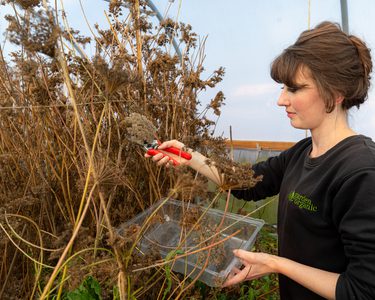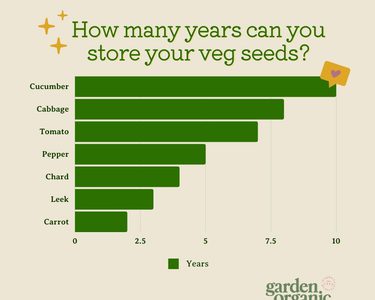Seeds for free

The simplest way to get fresh seeds for free is to save your own. In October tomatoes and beans are a great place to start. Leave a few of the healthiest pea/bean pods on the plant and allow them to dry on stems for as long as possible - when the seed resists a thumbnail mark it’s a good sign that they are ready. Tomatoes are even easier – when the fruit is ripe to eat the seed is ready to save (and you get to eat the rest of the fruit!)
Choose ripe fruit and use a sharp knife to cut the tomato in half on a chopping board. Scoop out the seeds with a teaspoon and separate them from the flesh. Place a sheet of paper towel on a plate and spread the seeds onto the sheet using the back of a spoon. Pop on a windowsill and leave to dry.
As a rule of thumb, drying your harvested seed at room temperature for a couple of weeks before storage will usually be sufficient for next year’s supply.
If you’re thinking of scaling up to save a larger quantity and range of seed, then it’s worth bearing in mind that crops grown for seed generally grow for longer and grow larger before harvest than when grown for food. Most will benefit from more space and a longer growing season. Dip into our free online seed saving guidelines for advice.
Look after your packets 🔗
Whether home-saved or shop-bought, it’s always worth properly looking after the seed you have. Most seed responds well to dry and cool conditions to keep viable for longer.
Keeping seed dry is more important than keeping it cool so avoid storing opened packets in damp spaces or containers that can trap condensation, such as plastic bags. Heat can destroy viability, and seeds should never be exposed to temperatures greater than 35˚C (95˚F) - so avoid drying or storing in an airing cupboard or greenhouse! Generally, keeping your seed in a paper envelope on a cool, dry shelf will do the trick.
For longer-term storage you could consider keeping them in the fridge or freezer. Make sure they’re completely dry and sealed in an airtight container before you do. A dry seed will last longer at room temperature than a moist seed in the fridge.
Get to know shelf life 🔗
Don’t give up on your older packets; I am ever the optimist with even the oldest seed with a low germination rate. It’s worth knowing that the shelf-life of seed can vary enormously depending on the type of vegetable. While the average for carefully-stored vegetable seed is four or five years, some vegetables, such as cabbage or tomato, can exceed eight years. At the other end of the scale is parsnip with only about a year before germination rates can fall sharply. Learn more in our panel below.

Consider pre-germinating seed 🔗
For that extra helping hand you can try pre-germinating seed on moist tissue or coffee filter paper before carefully transferring into a tray or pot when they start to sprout. Simply place the seed in dampened folds and check regularly.
Most vegetable seed will germinate in 5-10 days at room temperature. We use this method here at the Heritage Seed Library for older or scarce seed we need to handle as fragile. Germination testing will help you determine the percentage of seeds that are alive and can also help you plan to sow only the number of seeds you need.